| |
NOTE: The following article is based on teachings at a recent Push-hands
Seminar conducted by Zhang Yun in Philadelphia. It was edited by Dr. Susan
Darley, a student of Zhang Yun for the past five years.
Pile Standing
Zhan Zhuang - Pile standing is the most common training method in traditional
Chinese martial arts. Almost every style and group has its own version of this useful
practice. Whatever the variation, pile standing involves holding a fixed posture for a
period of time. Occasionally, the posture may include a few uncomplicated shifts of
position, but usually it requires that the practitioner stand still, like a piling or pole.
Because the movements of pile standing are easy and simple compared to many
other training methods, pile standing allows practitioners to concentrate more fully
on the details of internal training.
Taiji Quan is an internal martial art and one of its primary goals is internal training.
The first step in such training is to increase one’s control of the internal
components Shen (spirit), Yi (mind) and Qi. Pile standing is a particularly effective
way to accomplish this control. Increase in control of the internal components
gradually creates feelings that cause subtle adjustments in the body. These internal
alterations, in turn, increase one’s energy and abilities.
The process of increasing internal control happens slowly, so much time must be
allowed for this practice and the training must be careful and regular. For beginners,
practice should occur daily and for a period of at least one hundred days. A given
pile stance should be held for as many minutes as the correct flow of mind and Qi
can be maintained. Holding a pile stance in this way for 15 to 20 minutes will
produce significant gains in the development of basic skills.
In traditional Taiji Quan practice, pile standing is a commonly used training method,
especially for beginners, and "Qixing Zhuang" or Seven-Star Pile Standing is the
most frequently practiced Wu style Taiji Quan training stance. Careful practice of
seven-star pile standing can significantly enhance the development of rooting,
internal energy, relaxation, sensitivity, body integration, and control of the internal
components.
|
|
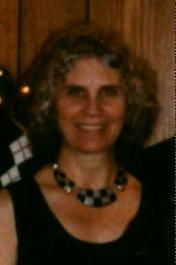 |
|
|
|
Susan Darley
|
|
|
|
| |
Seven-Star Pile Standing
Although the original meaning of seven-star is "plough," the phase in traditional
Chinese martial arts usually refers to the seven key acupoints on the body. These
points are very important for martial arts practice. They are: the "head star" at
Baihui point (on the top of the head); the "shoulder star" at Jianjing point (on the
Yang-side shoulder); the "elbow star" at Quchi point (on the elbow of the Yang-side
arm); the "hand star" at Laogong point (on the Yang-side palm); the "hip star" at
Huantiao point (on the Yang-side hip); the "knee star" at Yanglingquan point (on the
knee of the Yang-side leg); and the "foot star" at Yongquan point (on the ball of the
Yang-side foot).
In Taiji Quan practice, each side of the body is considered separately. The Yang
side is the active and insubstantial (unweighted or empty) side; the Yin side is the
quiet and substantial (weighted) side. Each side includes one leg and the opposing
arm. The Yin and Yang qualities are exchanged whenever movements involve
weight shifts. This changing of Yin and Yang sides is the source of all Taiji skills.
The Yin-side leg is the leg that holds most or all of the body’s weight, while the
Yang-side or empty leg bears none or only a relatively small amount of weight. The
arm on the side of the body opposite from the Yin leg is considered to be the
Yin-side arm and, likewise, the Yang-side arm is on the opposite side of the body
from the Yang leg. When, for example, the right leg is weighted, this leg is the Yin or
Yin-side leg, and the left leg is the Yang leg. The right arm is the Yang arm, and the
left arm is the Yin arm.
Because the Yang side is the active side, the focus of the mind during a stationary
posture such as seven-star pile standing is always on this side. In seven-star pile
standing, six of the seven stars on which the mind will focus are on the Yang side
arm and leg. Baihui, the head star, is also called Ding Pan Xin or "criterion" star. It
is of primary importance for maintaining Zhong Ding or central equilibrium.
Because it never changes, it is not associated with either side of the body. One of
the foremost goals of seven-star pile standing is to increase the smooth,
free-flowing movement of the internal components along the seven key points.
|
|
| |
Seven-Star Pile Standing Movement Description
The basic movement of seven-star pile standing is the same as the Hold
Seven-Star posture in the empty-hand form. This posture is one of the most
important in the form. In this posture, a sitting stance is used, which keeps one
hundred percent of the weight on one leg. When you hold this posture, if your weight
is on the right leg and your left arm is extended in front of your body, you are in a
"left posture"; otherwise, you are in a "right posture." Here, we will just describe the
left posture. For the right posture, everything is same except the designation of
sides, which should be reversed.
|
|
| |
Preparatory Movements
Stand facing forward with your feet parallel. There should be a distance of about the
width of one fist (about 4 inches) between your feet. Relax your mind and body.
Make your breathing slow, deep and smooth.
Slowly rock from side-to-side letting your feet move as necessary to achieve a
comfortable stance. The distance between your feet at this point should be wider
than one fist, but the maximum distance should not exceed the distance between
the left and right shoulders.
Think about a vertical line connecting the Jianjing point on each shoulder to the
Yongquan point on the corresponding foot. Keep your breathing smooth and your
body relaxed. Feel as though your body is sinking slightly down. This will create a
sense of stability and heaviness. Soon you will feel as though you are starting to
become sleepy. From this point on, you should not try to control your breathing in
any way; just forget about it and let it occur naturally.
As soon as you notice the sleepiness, focus your mind on the Baihui point at the top
of your head to bring your Shen (spirit) up. This will create a sense of alertness.
Ideally, you can become so alert that it is possible to feel the air moving along your
body. Although you are standing still with your eyes looking forward, this alertness
will allow you to be aware of whatever may be going on around you. Do not let your
gaze fasten on any particular object but remain relaxed and attentive (Fig. 1).
|
|
|
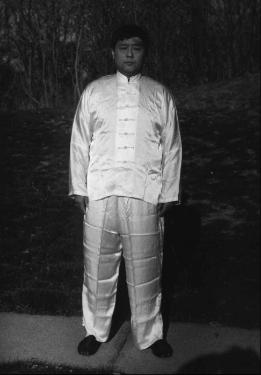 |
|
|
|
Fig. 1
|
|
|
|
| |
(1) Sinking Down of the Body
From Baihui, bring your mind to the left Jianjing point and let your left shoulder fully
relax so that your left arm feels as though it could effortlessly be detached from your
body.
Next, focus your mind on the left Quchi point on your left elbow and then move it
down to the left Laogong point on your left hand. As your mind moves down to your
left hand, you will feel like bending your legs. Follow this feeling and let your body
sink down. Your body will feel heavy and your stance will become very stable. In
spite of the sensation of heaviness, you should feel as though there is a spring
inside your leg that balances the downward push of your body. Your left hand should
also feel heavy and as though the palm is reaching downward to touch the floor. At
this point, the fingers of both hands should point forward and both palms should
face down.
(2) Extension of the Left Arm and Weight-Shift to the Right Leg
Keep your mind on your left hand until you feel as though your left arm wants to
move up. Then let the arm move forward and up follow this feeling. Remember that it
is always important in Taiji Quan practice to concentrate the mind and then wait until
the feeling for a movement exists before you actually execute the movement. As
expressed in a classic tenet of Taiji practice, movement always occurs: "First in
mind, then in body."
As your mind continues to focus on the left Laogong point of your left hand, your
weight should start to shift to your right leg. Then, bring your mind to the left Quchi
point on your left elbow and continue shifting your weight to the right leg as your left
arm continues to move up and forward on a slight diagonal to the right.
As your mind moves to the Jianjing point on your left shoulder, your weight should
shift completely to your right leg, and your left arm should be extended in front of you
with the elbow slightly bent and the left thumb opposite your nose. Throughout the
movement of your left arm, you should feel as though your shoulder has been
chasing your elbow which, in turn, has been chasing your hand.
At the end of this movement, your right leg should be fully weighted and your right
toes, right knee, and nose should be aligned in a vertical line. Your left leg should be
completely empty (Fig. 2).
(3) Extension of the Right Arm
Now, move your mind from the left to the right Jianjing point and feel your right arm
become relaxed. Only when you feel as though your right arm wants to move up,
should you let this movement occur.
As your mind moves down to the Quchi point on your right elbow and then to the
Laogong point on your right hand, your right arm should continue to move up and
forward on a slight diagonal toward the center of your body until your right middle
finger touches the crook of your left elbow. Your right thumb should point to
Tanzhong point (in the middle of your chest and at the level of your nipples).
(4) Extension of the Left Leg and Upward Turn of the Left Palm
Next, let your mind focus first on the Tangzhong point and then down to Dantian
(inside the abdomen about three inches behind the navel). Let your mind remain
briefly at Dantian before moving it to the Huiyin point (on the perineum midway
between the sexual organs and the anus). Focus your mind next on the Huantiao
point on your left hip.
When your mind is focused on your left hip, wait until your left leg seems ready to
move of its own accord before letting it begin to extend outward in front of your body.
From the left hip, bring your mind respectively to the Yanglingquan point on your left
knee and then to the Yongquan point on your left foot. Your left leg should continue to
move forward and when it is fully extended, your body will have assumed a sitting
stance with your left heel touching the floor and your toes pointing up.
While your left leg moves forward, your left palm, which had been facing to the right
side, should turn up in a counterclockwise direction. It is important when you turn
your palm that your left thumb does not move but instead remains opposite your
nose, having acted as a pivot point for the upturning palm (Fig. 3 and 4).
(5) Completion of the Opening Circle of the "Hold Seven-Star" Posture
When your mind is focused on the Yongquan point of your left foot, it will have
moved through all of the seven "stars," three of which – the shoulder, elbow and
hand – are on the Yang arm and three of which – the hip, knee and foot – are on
the Yang leg. The seventh or "criterion" star is Baihui at the top of the head. To
complete the opening circle, you should bring your mind from the left foot star back
to Baihui. This insures that your Shen will be up, thereby creating a sense of
nimbleness along with the stability that has been achieved through taking the stance.
Having assumed the "seven-star" pile standing, you now begin to move your mind
and Qi through as many circuits around the seven key points as possible. Typically,
you should try to work your way up to holding the stance and maintaining the circling
of mind and Qi for increasing periods of time.
(6) Circling of Mind during Seven-Star Pile Standing
Although pile standing is a stationary practice, all the internal components should be
in continuous movement inside your body during the maintenance of the stance. It is
in this sense that pile standing is an internal practice. The internal movement of
Shen, Yi and Qi will always bring some feeling or tendency toward physical
movement. It is said that to intend something will lead or direct the mind, that the
mind can then be used to lead Qi and that Qi, in turn, can be used to create the urge
to move.
To begin the first small circle of seven-star pile standing, bring your mind from the
"head star" Baihui to the right "shoulder star" Jianjing and then to the right "elbow
star" Quchi and on to the right "hand star" Laogong. From here, your mind should
move, with Qi following, through your right thumb to Tanzhong.
To begin the first big circle, bring your mind from Tanzhong to Dantian and then to
the left "hip star" Huantiao, onto left "knee star" Yanglingquan and then to the left
"foot star" Yongquan. Your mind should then move immediately from the big toe of
your left foot in a large imaginary circular path back to Baihui.
At this point, move your mind straight down from Bahui to the Yongquan point on the
bottom of your right foot. Your body will feel heavy and there will be a strong
sensation of compression in your right leg. Bring your mind to your extended left
palm and imagine that your right foot is resting on that palm so that your left hand is
holding up your whole body. This will lead you to feel that your body is sinking down
more and more onto your right leg. As this occurs, imagine the force increasing on
your left hand as it supports your sinking body.
Maintain this thought until you feel as though your right leg is very hot and as though
you cannot hold your body up any longer. Then, let your mind return to Baihui. This
will cause you feel more relax and your right leg to become more comfortable.
Begin another circuit of your mind through the "head star" acupoints (Fig. 5).
Repeat the circling of your mind as many times as your skill and strength allow.
Maintain a sense of physical relaxation and stability while at the same time
experiencing internal excitement and springiness. Thus, you will be enhancing your
capacity for nimbleness of movement as well as increasing your root.
(7) Closing form
When you feel that you can no longer maintain enough focus to move your mind
smoothly through the seven-star circles, it is the time to close your pile standing
practice.
As your mind returns to Baihui at the end of the last seven-star circuit, withdraw your
left foot back toward your body and place it alongside your right foot with both legs
bent. Be careful not to raise your body up as you bring your left leg in.
At the same time, bring your arms back toward your body, letting your hands cross
in front of your chest, a little bit higher than your nipples. Your gaze will naturally
lower (Fig. 6) and you will be ready for the last mind and Qi circle practice, called
Xiao Zhoutian or microcosmic orbit.
|
|
|
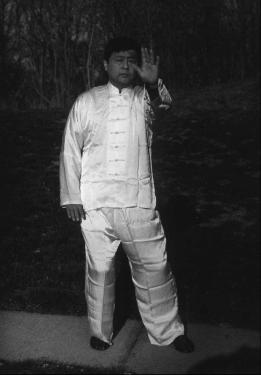 |
|
|
|
Fig. 2
|
|
|
|
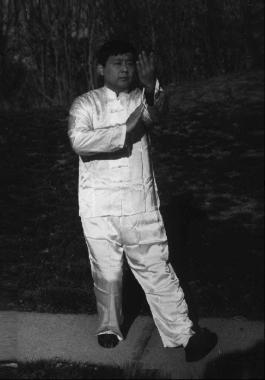 |
|
|
|
Fig. 3
|
|
|
|
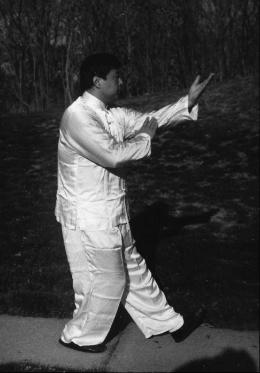 |
|
|
|
Fig.
4
|
|
|
|
 |
|
|
|
Fig. 5
|
|
|
|
 |
|
|
|
Fig.
6
|
|
|
|
| |
Xiao Zhoutian - Microcosmic Orbit
Move your mind to Dantian and then to Huiyin. At the same time, separate your
hands slightly so that the tips of your middle fingers touch each other and likewise
your index fingers and thumbs. Your nose should be directly above your middle
fingers. Slowly start to move your hands down along the centerline of your body and
simultaneously begin to straighten your legs so that your body gradually rises up.
As your hands move down, bring your mind to the Mingmen point at the center of
your lower back. This point is also known as the first of the "three back gates."
Separate your middle fingers as your hands pass Tanzhong and make sure that
your nose is directly above your index fingers.
Continue to push your hands slowly down in front of your body and bring your mind
to the Jiaji point at the center of your upper back. As your mind moves up through
this second "back gate" and your hands move down in front of the Zhongwan point
between Tanzhong and your navel, separate the tips of your index fingers. Your
nose should now be directly above your thumbs.
Bring your mind up to the third "back gate", the Yuzhen point on the back of the
head where the head joins the neck. Separate the tips of your thumbs as your hands
pass the Shenqie point on your navel. Look forward and let your mind move up and
return to the head star Baihui.
Let your hands relax alongside your body with each thumb touching the
corresponding thigh and your fingers fanned slightly outward. At this point, your legs
should be complete straight and your posture should be comfortably erect.
When your movement has finished, you will feel Qi flowing from Baihui down the
front of your face like a gentle waterfall. Move your mind, followed by Qi, down to
Dantian and then bring your fingers to rest along the sides of your legs.
Check your breathing. It should be smooth and perfectly calm. You should feel very
comfortable and relaxed as you complete seven-star pile standing.
|
|
| |
Conclusion
Seven-star pile standing can improve your understanding of both Taiji Quan
principle and also the internal sensations that underlie the proper execution of many
basic skills. These feelings and understanding will then refine your form practice.
Pile standing and form practice can supplement each other. A traditional saying in
Taiji Quan is: "One step, one pile," which means that every movement in the Taiji
form can be used as a pile standing practice and also that every movement in the
form should be practiced as though it were a pile standing. Although pile standing is
very important, for advance study, it should be combined in form practice generally.
So that form is usually called Dong Zhuang - "Moving Pile Standing". In fact Taiji
Quan is a dynamic rather than a static expression of skills.
|
|
| |
|
|
|

